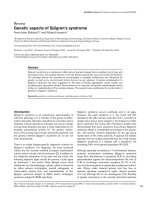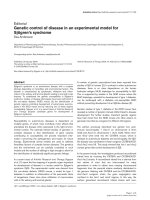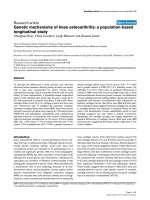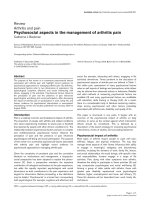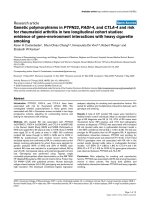Báo cáo y học: "Genetic aspects of fibromyalgia syndrome" pptx
Bạn đang xem bản rút gọn của tài liệu. Xem và tải ngay bản đầy đủ của tài liệu tại đây (49.8 KB, 5 trang )
Page 1 of 5
(page number not for citation purposes)
Available online />Abstract
Genetic and environmental factors may play a role in the etio-
pathology of fibromyalgia syndrome (FMS) and other related
syndromes. There is a high aggregation of FMS in families of FMS
patients. The mode of inheritance is unknown but it is most
probably polygenic. There is evidence that polymorphisms of
genes in the serotoninergic, dopaminergic and catecholaminergic
systems play a role in the etiology of FMS. These polymorphisms
are not specific for FMS and are associated with other functional
somatic disorders and depression. Future genetic studies in the
field of FMS and related conditions should be conducted in larger
cohorts of patients and ethnically matched control groups.
Introduction
Fibromyalgia is an idiopathic, chronic pain syndrome defined
by widespread nonarticular musculoskeletal pain and general-
ized tender points [1]. Fibromyalgia syndrome (FMS) overlaps
with several related syndromes, the functional somatic syn-
dromes [2]. The pathogenesis of FMS and related conditions
is not entirely understood, although the current concept
views FMS as the result of central nervous system mal-
function, resulting in amplification of pain transmission and
interpretation [3,4]. Recent evidence suggests that FMS and
related syndromes share heritable pathophysiological
features [5,6]. Certain environmental factors may trigger the
development of FMS and related conditions in genetically
predisposed individuals [7]. The aim of this article is to review
the current evidence that genetic and familial factors may play
a role in the development of FMS.
Familial aggregation in fibromyalgia
The prevalence of FMS in the general population is estimated
at 2% [8]. The prevalence of FMS and the observation of
rheumatologists that this syndrome runs in families suggest
that genetic and familial factors may play a role in its etio-
pathogenesis. Several studies have addressed the frequency
of FMS in families of patients with FMS.
Two studies [9,10] suggested that FMS segregates within
families in an autosomal dominant mode of inheritance. One of
them [9], based on clinical diagnostic criteria modified from
Yunus, showed female preponderance and, in addition, postu-
lated the existence of a latent or precursor stage of the disease
characterized by abnormal palpable muscle consistency. If such
a latent stage exists, this study actually showed that 70% of
offspring of FMS patients are affected, a rate that considerably
exceeds the one expected from autosomal dominant inheritance
(50%) and suggests over-diagnosis in this study. In addition,
this study rejected the polygenic mode of inheritance based on
data on second degree relatives, which was not presented in
the article. The second study by Stormorken and colleagues
[10] was based on data retrieved from questionnaires regarding
FMS symptoms in family members of index patients.
According to this study, about two-thirds of the study
population reported family clustering. However, the statement
regarding a clear pattern of dominant inheritance was not
corroborated by numerical data. A subsequent study
attempted to document the mother-child correlation with
regard to the occurrence of fibromyalgia, and also compared
sleep disorder patterns between a group of childhood
fibromyalgia patients and their mothers [11]. A significant
concordance was observed between children and mothers
regarding both occurrence of FMS and the sleep disorder.
Buskila and colleagues [12] analyzed the occurrence of FMS
among 58 offspring of 20 affected mothers with FMS; 16
offspring (28%) were found to have FMS. The male/female
ratio among those affected was 0.8 compared with 1.5 in the
whole group.
Offspring with and without FMS did not differ in anxiety,
depression, global well being, quality of life and physical
functioning. Because psychological and familial factors were
Review
Biology and therapy of fibromyalgia
Genetic aspects of fibromyalgia syndrome
Dan Buskila
1
and Piercarlo Sarzi-Puttini
2
1
Department of Medicine H, Soroka Medical Center and Faculty of Health Sciences, Ben Gurion University, Beer Sheva, Israel
2
Department of Rheumatology, University Hospital L. Sacco, Milan, Italy
Corresponding author: Dan Buskila,
Published: 28 July 2006 Arthritis Research & Therapy 2006, 8:218 (doi:10.1186/ar2005)
This article is online at />© 2006 BioMed Central Ltd
ASD = affective spectrum disorder; CFS = chronic fatigue syndrome; COMT = catechol-O-methyltransferase; FMS = fibromyalgia syndrome.
Page 2 of 5
(page number not for citation purposes)
Arthritis Research & Therapy Vol 8 No 5 Buskila and Sarzi-Puttini
not different in children with and without FMS, the high
familial occurrence of this syndrome was suggested to be
attributed to genetic factors [12].
In another study [13], the authors further observed 30 female
patients with FMS and 117 of their close relatives (parents,
brothers, sisters, children and husbands). The prevalence of
FMS among the blood relatives of patients with FMS was
26%, compared to 19% among their husbands. Fibromyalgia
prevalence was 14% in male relatives and 41% in female
relatives. It was suggested that the higher prevalence of FMS
in relatives could be attributed to genetic and environmental
factors [13]. The quality of life and physical functioning of
these relatives were found to be impaired, especially in
female relatives and those with undiagnosed FMS [14].
Arnold and colleagues [15] tested the hypotheses that FMS
and measures of pain and tenderness aggregate in families
and that FMS co-aggregates with major mood disorder. They
performed a family interview study of 78 probands with FMS
and 40 probands with rheumatoid arthritis, assessing FMS
and major mood disorder in a total of 533 first degree
relatives (146 interviewed) of the probands with FMS and a
total of 272 first degree relatives (72 interviewed) of the
probands with rheumatoid arthritis.
Fibromyalgia aggregated strongly in families: the odds ratio
measuring the odds of fibromyalgia in a relative of a proband
with fibromyalgia versus the odds of fibromyalgia in a relative
of a proband with rheumatoid arthritis was 8.5. Moreover, the
number of tender points was significantly higher in relatives of
FMS patients compared to relatives of patients with rheuma-
toid arthritis. Fibromyalgia was also found to co-aggregate
with other forms of affective spectrum disorder (ASD). The
authors concluded that genetic factors are probably involved
in the etiology of fibromyalgia and pain sensitivity and that
fibromyalgia and mood disorders are likely to share such
inherited factors [15].
Mikkelsson and colleagues [16] examined the prevalence of
widespread musculoskeletal pain among 11 year old Finish
twins. The prevalence of widespread pain was 9.9% and
most twin pairs were discordant. The authors concluded that
genetic factors play only a minor role in widespread pain in
this population and that environmental factors shared by
family members accounted for a substantial proportion of the
variability in widespread pain.
The strong familial aggregation reported in FMS, though not
excluding a possible contribution by environmental factors,
appears to point to a genetic basis as an important
contributor to its etiology.
Genes involved in FMS
HLA antigen class I and II were determined in a small group
of FMS patients and normal controls [17]; 67% of FMS
patients had DR4 versus 30% of normal controls. Yunus and
colleagues [18] confirmed in a 40 multicase families study
the existence of a possible gene for FMS that is linked with
the HLA region (a weak association). It was emphasized that
these results should be confirmed independently by other
studies [18].
Research done in recent years has demonstrated a role for
polymorphisms of genes in the serotoninergic, dopaminergic
and catecholaminergic systems in the etiology of FMS.
Offenbaecher and colleagues [19] analyzed the genotypes of
the promoter region of the serotonin transporter gene
(5-HTT) in 62 patients with FMS and 110 healthy controls. A
significantly higher frequency of the S/S genotype of the
serotonin transporter promoter region was found in FMS
patients (31%) compared with healthy controls (16%). The
S/S subgroup exhibited higher mean levels of depression and
psychological distress. It was suggested that the results
support the notion of altered serotonin metabolism in at least
a subgroup of patients with FMS.
These researches have further investigated the silent T102C
polymorphism of the 5-HT2A receptor gene in 168 FMS
patients and 115 healthy controls [20]. Their results show a
significantly different genotype distribution in FMS patients,
with a decrease in T/T and an increase in both T/C and C/C
genotypes compared to the control population. However, the
increase in allele C102 frequency fell short of significance.
Correlation of genotypes to clinical parameters revealed no
influences on age of onset, duration of disease or psycho-
pathological syndromes, measured with the Beck Depression
Inventory and the symptom check list SCL-90-R. In contrast,
the pain score was significantly higher for patients with the
T/T genotype. It was suggested that the T102 allele might be
involved in the complex circuits of nociception.
It was concluded that the T102C polymorphism is not directly
involved in the etiology of FMS, but might be in linkage
dysequilibrium with the true functional variant, which has to
be unraveled [20].
To verify and extend these findings, Cohen and colleagues
[21] performed genotyping in a group of 99 female FMS
patients from two Israeli ethnic groups. Additionally, each
patient was assessed with the Tridimensional Personality
Questionnaire, a self report instrument consisting of 100
yes/no questions. The results of this study confirm the
association between FMS and the serotonin transporter
promoter region (5-HTTLPR) polymorphism in two ethnic
groups in Israel, Jewish and Bedouins.
A significant association between the 5-HTTLPR polymorphism
and anxiety related personality traits was found as well [21].
Gursoy could not find an association between the serotonin
transporter (5-HTT) nor its polymorphism with FMS [22].
Page 3 of 5
(page number not for citation purposes)
Zubieta and colleagues [23] examined the influence of a
common functional genetic polymorphism affecting the meta-
bolism of catecholamines on the modulation of responses to
sustained pain in humans. Individuals homozygous for the
Met158 allele of the catechol-O-methyltransferase (COMT)
polymorphism (Val158Met) show diminished regional mu-
opioid system responses to pain compared with hetero-
zygotes. These effects were accompanied by higher sensory
and affective ratings of pain and a more negative internal
affective state. It was concluded that the COMT Val158Met
polymorphism influences the human experience of pain and
may underlie inter-individual differences in the adaptation and
responses to pain and other stressful stimuli [23].
Gursoy and colleagues [24] have reported on the involve-
ment of COMT gene polymorphism in patients with FMS. It
was concluded that COMT polymorphism is of potential
pharmacological importance regarding individual differences
in the metabolism of catechol drugs and may also be
involved in the pathogenesis and treatment of FMS through
adrenergic mechanisms as well as genetic predisposition to
FMS [24].
In a recent study, Buskila and colleagues [25] reported a
significant decrease in the frequency of the 7 repeat allele in
exon III of the D4 receptor gene in FMS patients who also
demonstrated an association between this polymorphism and
the low novelty seeking personality trait. This was considered
consistent with the personality profile of FMS patients, who
score high on anxiety related personality traits and low on
novelty or sensation seeking.
These findings are interesting since altered dopamine D2
receptor function has been demonstrated in FMS patients
[26] and recent evidence has demonstrated the efficacy of
a dopamine-3 agonist, pramipexole, in patients with FMS
[27].
Altogether, recent evidence suggests a role for poly-
morphisms of genes in the serotoninergic, dopaminergic and
catecholaminergic systems in the etiopathogensis of FMS.
Genetic and familial factors in FMS: related
conditions
Fibromyalgia is one member of a group of medical disorders
collectively termed functional somatic syndromes [2] or, alter-
natively, ASD [28]. These syndromes include FMS, chronic
fatigue syndrome (CFS), irritable bowel syndrome, gulf war
syndrome and more [2].
Since these syndromes share many clinical features,
including generalized pain sensitivity, it is postulated that they
share common pathogenetic mechanisms. Indeed, Hudson
and colleagues [28] reported on familial aggregation of ASD
collectively and familial co-aggregation of FMS with other
forms of ASD.
Another study [29] evaluated 178 relatives of 64 probands
suffering from major depressive disorder and 152 relatives of
58 probands without major depressive disorder.
The estimated odds ratio (95% confidence interval) for the
familial aggregation of ASD as a whole was 2.5 (1.4-4.3,
P = 0.001) and for the familial co-aggregation of major
depressive disorder with at least one other from of ASD was
1.9 (1.1-3.2, P = 0.02). Thus, ASD was found to strongly
aggregate in families and major depressive disorder dis-
played a significant familial co-aggregation with other forms
of ASD, suggesting a shared genetic and pathophysiological
basis for these disorders [29].
A family history study was conducted among patients with
CFS [30]; 25 patients with CFS were compared to 36
control individuals, assessing for symptoms of fatigue as well
as psychiatric symptoms. Information was collected regarding
similar symptoms among first degree relatives of patients and
controls. Significantly higher rates of chronic fatigue were
identified among relatives of CFS patients compared to
relatives of healthy controls, suggesting a significant role for
familial factors in CFS. Familial aggregation of irritable bowel
syndrome also has been recently reported, supporting a
genetic or interfamilial environmental component [31].
A high prevalence of FMS was found among female migraine
patients [32]. It was shown that migraine, as well as other co-
morbid conditions, aggregates in families [29]. A significant
overlap exists between FMS and post-traumatic stress dis-
order according to the currently accepted diagnostic criteria
for each [33]. A twin study of Vietnam veterans has shown
significant genetic contribution to post-traumatic stress dis-
order [34].
Similar to the findings in FMS, polymorphism of genes in the
serotoninergic and dopaminergic systems have been repor-
ted for other functional somatic syndromes. A study
conducted in 78 CFS patients showed a significant increase
of longer allelic variants of the serotonin transporter (5-HTT)
gene promoter polymorphism, which affects the
transcriptional efficiency of 5-HTT [35].
It was concluded that attenuated concentration of extra-
cellular serotonin due to longer variants may cause higher
susceptibility to CFS. Serotonin transporter polymorphism
was shown to influence response to the 5-HT antagonist in
diarrhea predominant irritable bowel syndrome and influence
the benefit/risk ratio with this class of compounds [36].
Juhasz and colleagues [37] have suggested that the genetic
susceptibility of migraine may be associated with a locus at or
near the 5-HT transporter gene. Segman and colleagues [38]
reported on an association between the dopamine trans-
porter gene and post-traumatic stress disorder. It was
suggested that genetically determined changes in dopa-
Available online />minergic reactivity may contribute to the occurrence of post-
traumatic stress disorder among trauma survivors.
Lawford and colleagues [39] found that changes in social
functioning induced by paroxetine may be, in part, mediated
via D2 dopa receptors. It was suggested that the DRD2A1
allele may prove to be a useful marker to assist clinicians in
predicting which patients with post-traumatic stress disorder
are likely to obtain improvements in social functioning with
paroxetine treatment [39].
Conclusion
The pathogenesis of FMS and related conditions is not
entirely understood. Recent evidence suggests that these
syndromes may share heritable pathophysiological features.
Family studies showing familial aggregation of FMS and
related conditions raise the possibility that genetic factors are
involved in the development of these conditions. Research
done over the past years has demonstrated a role for poly-
morphisms of genes in the serotoninergic dopaminergic and
catecholaminergic systems in the etiopathogenesis of FMS
and other functional somatic syndromes.
The mode of inheritance of FMS is unknown, but it is most
probably polygenic. Environmental factors (mechanical trauma,
emotional trauma) may trigger the development of FMS in
genetically predisposed individuals.
More prospective studies, conducted in larger numbers of
patients and matched controls, are needed to better clarify
the role of genetics in FMS and related conditions.
Competing interests
The authors declare that they have no competing interests.
References
1. Wolfe F, Smythe HA, Yunus MB, Bennett RM, Bombardier C,
Goldenberg DL, Tugwell P, Campbell SM, Abeles M, Clark P, et
al.: The American College of Rheumatology criteria for the
classification of fibromyalgia: report of the multicenter criteria
committee. Arthritis Rheum 1990, 33:160-172.
2. Barsky MJ, Borus JF: Functional somatic syndromes. Ann Intern
Med 1999, 130:910-921.
3. Gracely RH, Petzke F, Wolf JM, Clauw DJ: Functional magnetic
resonance imaging evidence of augmented pain processing
in fibromyalgia. Arthritis Rheum 2002, 46:1333-1343.
4. Staud R, Vierck CJ, Cannon RL, Mauderli AP, Price DD: Abnor-
mal sensitization and temporal summation of second pain
(wind up) in patients with fibromyalgia syndrome. Pain 2001,
91:165-175.
5. Buskila D, Neumann L: Genetics of fibromyalgia. Curr Pain
Headache Rep 2005, 9:313-315.
6. Buskila D, Neumann L, Press J: Genetic factors in neuromuscu-
lar pain. CNS Spectr 2005, 10:281-284.
7. Clauw DJ, Crofford LJ: Chronic widespread pain and fibromyal-
gia what we know and what we need to know. Best Pract Res
Clin Rheumatol 2003, 17:685-701.
8. Wolfe F, Ross K, Anderson J, Russell IJ, Herbert L: The preva-
lence and characteristis of fibromyalgia in the general popula-
tion. Arthritis Rheum 1995, 38:19-28.
9. Pellegrino MJ, Walonis GW, Sommer A: Familial occurrence of
primary fibromyalgia. Arch Phys Med Rehabl 1989, 70:61-63.
10. Stormorken H, Brosstad F: Fibromyalgia: family clustering and
sensory urgency with early onset indicate genetic predisposition
and thus a “true” disease. Scand J Rheumatol 1992, 221:207.
11. Roizenblatt S, Tufik S, Goldenberg J, Pinto LR, Hilario MO,
Feldman D: Juvenile fibromyalgia: clinical and polysomno-
praphic aspects. J Rheumatol 1997, 24:579-585.
12. Buskila D, Neumann L, Hazanov I, Carmi R: Familial aggregation
in the fibromyalgia syndrome. Semin Arthritis Rheum 1996, 26:
605-611.
13. Buskila D, Neumann L: Fibromyalgia syndrome (FM) and
nonarticular tenderness in relatives of patients with FM. J
Rheumatol 1997, 24:941-944.
14. Neumann L, Buskila D: Quality of life and physical functioning
of relatives of fibromyalgia patients. Semin Arthritis Rheum
1997, 26:834-839.
15. Arnold LM, Hudson JL, Hess EV, Ware AE, Fritz DA, Auchenbach
MB, Starck LO, Keck PE Jr: Family study of fibromyalgia. Arthri-
tis Rheum 2004, 50:944-952.
16. Mikkelson M, Kaprio J, Salminen JJ, Pulkkinen L, Rose RJ: Wide-
spread pain among 11 year old Finish twin pairs. Arthritis
Rheum 2001, 44:481-485.
17. Burda CD, Cox FR, Osborne P: Histocompatibility antigens in
the fibrositis (Fibromyalgia) syndrome. Clin Exp Rheumatol
1986, 4:355-358.
18. Yunus MB, Khan MA, Rawlings KK, Green JR, Olson JM, Shah S:
Genetic linkage analysis of multicase families with fibromyal-
gia syndrome. J Rheumatol 1999, 26:408-412.
19. Offenbaecher M, Bondy B, de Jong S, Glatzeder K, Kruger M,
Schoeps P, Ackenheil M: Possible association of fibromyalgia
with a polymorphism in the regulatory region. Arthritis Rheum
1999, 42:2482-2488.
20. Bondy B, Spaeth M, Offenbaeher M, Glatzeder K, Stratz T,
Schwarz M, de Jong S, Kruger M, Engel RR, Farber L, et al.: The T
102 C polymorphism of the 5-HT2A receptor gene in
fibromyalgia. Neurobiol Dis 1999, 6:433-439.
21. Cohen H, Buskila D, Neumann L, Ebstein RP: Confirmation of an
association between fibromyalgia and serotonin transporter
promoter region (5-HTTLPR) polymorphism, and relationship
to anxiety related personality traits. Arthritis Rheum 2002, 46:
845-847.
22. Gursoy S: Absence of association of the serotonin transporter
gene polymorphism with the mentally healthy subset of
fibromyalgia patients. Clin Rheumatol 2002, 21:194-197.
23. Zubieta JK, Heitzeg MM, Smith YR, Bueller JA, Xu K, Xu Y,
Koeppe RA, Stohler CS, Goldman D: COMT val158met geno-
type affects mu-opioid neurotransmitter responses to a pain
stressor. Science 2003, 299:1240-1243.
24. Gursoy S, Erdal E, Herken H, Madenci E, Ala B, Erdal N: Signifi-
cance of catechol-O-methyltransferase gene polymorphism in
fibromyalgia syndrome. Rheumatol Int 2003, 23:104-107.
25. Buskila D, Cohen H, Neumann L, Ebstein RP: An association
between fibromyalgia and the dopamine D4 receptor exon III
repeat polymorphism and relationship personality traits. Mol
Psychiatry 2004, 9:730-731.
26. Malt EA, Olafsson S, Aakvaag A, Lund A, Ursin H: Altered
dopamine D2 receptor function in fibromyalgia patients: a
neuroendocrine study with buspirone in women with fibro-
myalgia compared to female population based controls. J
Affect Disord 2003, 75:77-82.
27. Holman AJ, Myers RR: A randomized, double blind plcebo con-
trolled trial of pramipexole, a dopamine agonist in patients
with fibromyalgia receiving concomitant medications. Arthritis
Rheum 2005, 52:2495-2505.
28. Hudson JI, Arnold LM, Keck PE Jr, Auchenbach MB, Pope HG Jr:
Family study of fibromyalgia and affective spectrum disorder.
Biol Psyhiatry 2004, 56:884-891.
Arthritis Research & Therapy Vol 8 No 5 Buskila and Sarzi-Puttini
Page 4 of 5
(page number not for citation purposes)
This review is part of a series on
Biology and therapy of fibromyalgia
edited by Leslie Crofford.
Other articles in this series can be found at
/>review-series.asp?series=ar_fibromyalgia
29. Hudson JI, Mangweth B, Pope HG JR, De COL C, Hausmann A,
Gutweniger S, Laird NM, Biebl W, Tsuang MT: Family study of
affective spectrum disorder. Arch Gene Psychiatry 2003, 60:
170-177.
30. Walsh CM, Zainal NZ, Middleton SJ, Paykele ES: A family history
study of chronic fatigue syndrome. Psychiatr Genet 2001, 11:
123-128.
31. Kalamtar JS, Locke GR, Zinsmeister AR, Beighley CM, Talley NJ:
Familial aggregation of irritable bowel syndrome: a prospec-
tive study. Gut 2003, 52:1703-1707.
32. Ifergane G, Buskila D, Simiseshvely N, Zeev K, Cohen H: Preva-
lence of fibromyalgia syndrome in migraine patients Cephal-
gia. 2006, 26:451-456.
33. Cohen H, Neumann L, Haiman Y, Matar MA, Press J, Buskila D:
Prevalence of post traumatic stress disorder in fibromyalgia
patients: overlapping syndromes or post traumatic fibromyal-
gia syndrome? Semin Arthritis Rheum 2002, 32:38-50.
34. Koenen KC, Lyons MJ, Goldenberg J, Simpson J, Williams WM,
Toomey R, Eisen SA, True WR, Cloitre M, Wolfe J, Tsuang MT: A
high risk twin study of combat related PTSD co-morbidity.
Twin Res 2003, 6:218-226.
35. Narita M, Nishigami N, Narita N, Yamaguti K, Okado N, Watanabe
Y, Kuratsune H: Association between serotonin transporter
gene polymorphism and chronic fatigue syndrome. Biochem
Biophys Res Commun 2003, 311:264-266.
36. Camilleri M, Atanasova E, Kim HJ, Viramontes BE, Mckinzie S,
Urrutia R: Serotonin-transporter polymorphism pharmacoge-
netics in diarrhea-predominant irritable bowel syndrome. Gas-
troenterology 2002, 123:425-432.
37. Juhasz G, Zsombok T, Laszik A, Gonda X, Sotonyi P, Faludi G,
Bagdy G: Association analysis of 5-HTTLPR variants. 5-HT2a
resptor gene 102 T/C polymorphism and migraine. J Neuro-
genet 2003, 17:231-240.
38. Segman RH, Cooper Kazaz R, Macciardi F, Goltser T, Halfon Y,
Dobroborski T, Shalev AY: Association between the dopamine
transporter gene and posttraumatic stress disorder. Mol Psy-
chiatry 2002, 7:903-907.
39. Lawford BR, McD Young R, Noble EP, Kann B, Arnold L, Rowell J,
Ritchie TL: D2 dopamine receptor gene polymorphism: parox-
etine and social functioning in posttraumatic stress disorder.
Eur Neuropsychopharmacol 2003, 13:313-320.
Available online />Page 5 of 5
(page number not for citation purposes)

